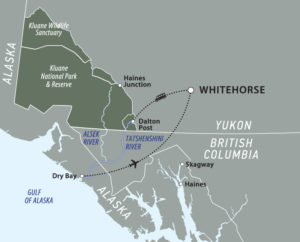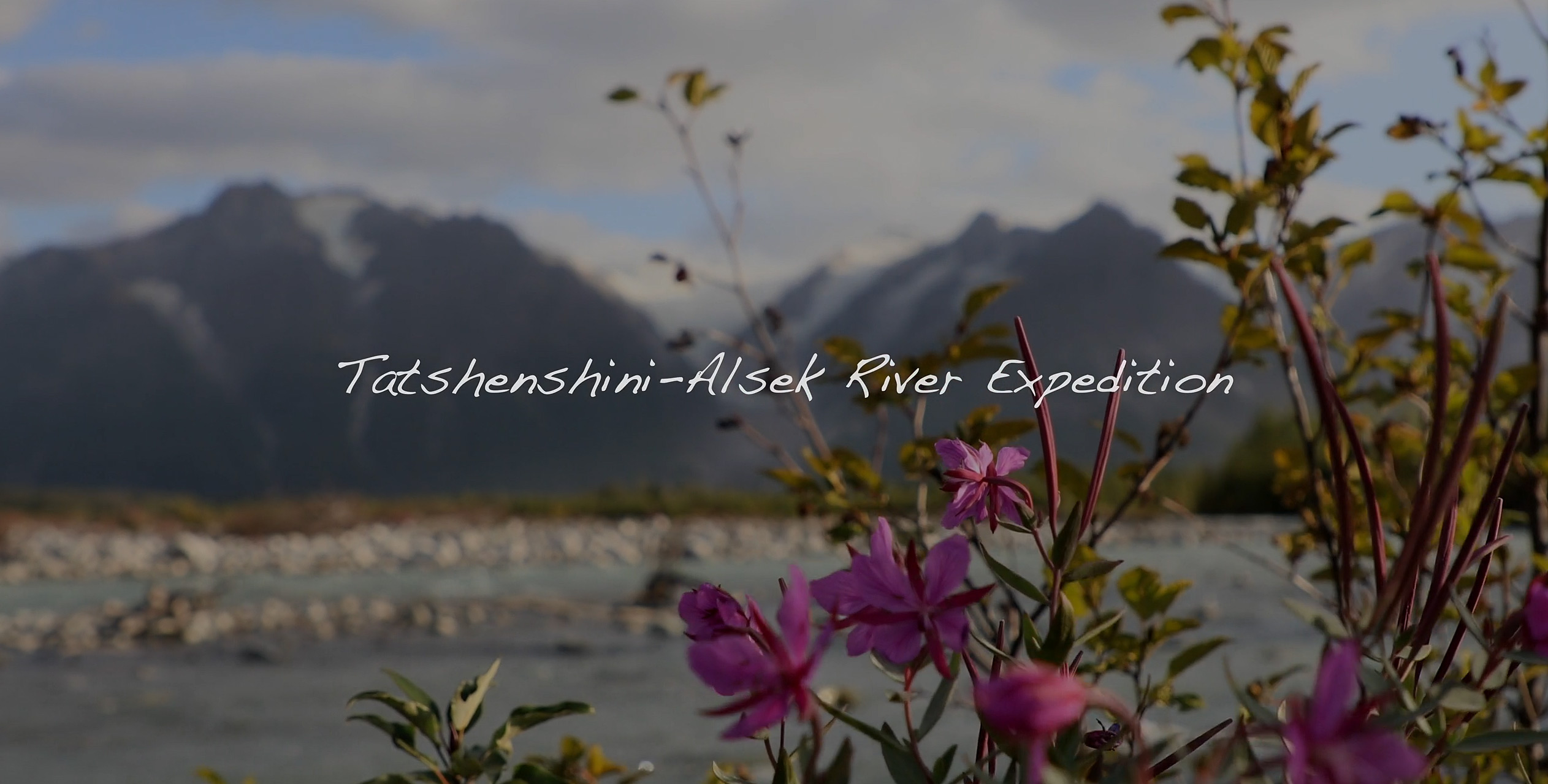13 Day River Expedition
$7995 USD
per person based on double occupancy
2026 Dates:
June, July & August:
Deposit: $1000 Meeting Place: Whitehorse, YK Gateway City: Whitehorse, YK
Single Supplement: $750, River Rating: Class III Age Range: 14-80*
In the northwest corner of the continent, where the boundaries of British Columbia, the Yukon and Alaska converge, the Tatshenshini and Alsek rivers flow amidst three-mile-high mountains. The Tat-Alsek river trip is the only river that travels from the interior plateau to the ocean with a major waterfall. Starting as a small creek in the Yukon, the the river doubles in size each day and traverses the largest protected wilderness on the planet. Our trips are designed to allow layover days in the best locations for hiking and wildlife viewing. The St Elias Mountains are home to the largest non-polar ice fields in the world. Massive glaciers descend to the water’s edge, shearing off thunderously into calving icebergs. The primeval landscape, dominated by grizzlies, ravens and eagles is wilderness in its purest form.
ROAM’s Tatshenshini trips start in Whitehorse which allows us to use larger aircraft to fly out at the end of the river expedition. This is not a trivial matter, as the larger aircraft have better track records for efficiency and inclement weather but also allows us to carry all manner of fresh fruit, meat, seafood and vegetables, along with an impressive selection of bottled wines, micro brew beers and liquor. With only 12 guests on the adventure, you will be certain to have an intimate experience as we journey through alpine tundra, past towering mountains with massive glaciers that often reach right into the river, and finally out onto the narrow coastal plain. Come experience this rugged wilderness with the legendary service and hospitality that ROAM’s river trips are known for.

Itinerary at a Glance
- Our adventure begins with a number of lively Class III rapids and a spectacular view of quintessential northern wilderness
- Each day the scenery gets increasingly spectacular as mountains rise to 8000 feet and glaciers hang from every slope
- See bear, moose, goats and perhaps wolves and lynx
- Campsite vistas span the broad expanse of the Tatshenshini and Alsek river valleys, flanked by more than 50 different glaciers
- Hike Walker Glacier
- Paddle through the iceberg-laden waters of Alsek Lake
- View the St. Elias Mountains, the largest concentration of high peaks in North America,
- Enjoy a spectacular flight back to Whitehorse
What’s Included:
- Experienced professional guides
- Charter flight from Dry Bay to Whitehorse
- Transfer from Whitehorse to the river
- Expedition equipment including: tent, sleeping bag, sleeping pad, rain suits, rubber boots and dry bags
- All meals on the river
- Beer, wine and some liqueurs
- Park fees and necessary permits
What to Expect on the Tatshenshini River Expedition
We pride ourselves in running a relaxed and flexible schedule. Every trip is different, depending upon the group, National Park notices, and sometimes the weather. The following is a sample of what your trip might be like.
Day One
Today is your arrival day in Whitehorse. After checking in to your hotel, plan to meet us in at 7:00pm in the lobby for a welcome dinner and briefing. Overnight Whitehorse
Day Two
We will depart at 8:00 AM for the 2 1/2 hour drive to the put-in at Dalton Post. From Whitehorse we’ll head North on the Alaska Highway to Haines Junction and then west along the Haines Road to the Dalton Post turn off. At this old, abandoned trading post, we’ll meet the other guides, load the rafts and leave civilization behind us. This first day, we will run a number of lively Class III rapids through the gorge then emerge, a few hours later, into a wide open valley to see our first views of the mountains with their hanging glaciers. That night, we’ll set up camp at Silver Creek.
Days Three & Four
The river will slow down a little as we float through this incredible valley. Upon entering B.C., the river meanders through lush landscapes and is home to a variety of birds, moose and beaver. The mountains to the southwest will seem to get larger as we pass the river terraces, all the while keeping a watchful eye out for the elusive blue bear, grizzly, mountain goat and wolf. Various tributaries double the size of the river and every turn produces a fantastic panoramic view. We will spend two days stationed near Sediments Creek where we can hike and explore the alpine region’s most diverse ecosystem.
Days Five & Six
We’ll continue down the Tat and stop for lunch at O’Connor Creek. Every day the scenery will get more spectacular; mountains rise to 8,000 feet; glaciers hang from every mountainside. The river valley will continue to widen as we reach our camp near the confluence with the Alsek River. Here there are great hiking opportunities along the river terraces where wildflowers carpet the ground.
Days Seven & Eight
We join the mighty Alsek River flowing from the North as we travel through the braided channels. The river will seem to narrow as the mountains reach for the sky. A 360-degree look will reveal over 50 glaciers as we near our camp at Walker Glacier. We’ll marvel at the crevasses and hike onto the massive moraines. Later, around the campfire, we’ll enjoy some fine scotch with 10,000-year-old ice collected from the glacier earlier in the day.
Days Nine & Ten
Cutting through the Brabazon Range, we’ll pass the massive Novatak Glacier which is the tip of one of the largest ice fields outside of the polar regions. To the south, (at 15,300 ft), Mount Fairweather, the fourth highest mountain on the continent, will dwarf our very existence. Tonight, we’ll camp on the spit that separates the Alsek River from Alsek Lake, a five kilometer lake located at the bottom of the massive Alsek Glacier. In the afternoon, we will paddle out to the edge of the glacier and watch as giant, 100-foot pieces of the ice calve off with a thunderous roar and form icebergs in the lake. Our view from camp is one of the most spectacular anywhere on earth.
Days Eleven & Twelve
We’ll float through the icebergs in Alsek Lake as we make our way south of the Gateway Knob. Cruising in and out of the ice makes for an exhilarating morning and fantastic photographic opportunities. After breaking camp, we’ll float the last miles down to the airstrip at Dry Bay on the shores of the Pacific Ocean. Here, we’ll disembark, collapse the rafts and board the plane for the scenic flight over the mountains back to Whitehorse. Once back in civilization, it’s off to the hotel and a well deserved hot shower. Tonight, we’ll all get together for a last toast to the Tatshenshini and plan our next adventure together.
Day Thirteen
Depart for home at your leisure.
About the Region
The Terrain
Our journey will take us through alpine tundra, past towering mountains with massive glaciers that often reach right into the river, and finally out onto the narrow coastal plain. This is the primeval land of the grizzly, the raven and the eagle; wilderness in its purest form. It has always been difficult to visit this remote corner of the world and settlements are few and very far between. The trappers and prospectors who came through in previous centuries endured extreme hardship to travel in the area -many did not survive. But “The Spell of the Yukon” has always been there and even today, Alaska and the Yukon have a place in the psyche of every adventurous North American.
This trip offers you a way to get completely away from civilization. On the river you will see no cars, no bridges, no wires. You will not hear a telephone or a television. A fax machine will seem as far away as it did 20 years ago. But if you ever thought of this part of the world as empty, a few days on the Tatshenshini will change that impression. Distances between things may be great but the abundance of life that manages to make the most of the short summer and long days will constantly surprise you and you will see why this region has become the largest international wilderness area in the world.
Wildlife and Flora
The valley of the Tatshenshini is a fantastic area for viewing wildlife. Wildlife sightings have included grizzly and black bear, moose, Dall sheep, mountain goat and wolf. Indigenous species also include coyote, lynx, marten and red fox. On the open country we are quite likely to see beaver, arctic ground squirrel and hoary marmot. Feeding on the salmon are many breeding pairs of bald eagles. The occasional golden eagle can also be seen soaring over the canyons of the upper Tat. A variety of hawks and the rare peregrine falcon also call this river valley home. Canada geese and the fish eating merganser are found along the river; while gulls and arctic terns are often seen as well.
While hiking we may come across ptarmigan and many varieties of songbirds. The giant spring or king salmon, coho, sockeye and chum salmon all spawn in the Tatshenshini and its tributaries while rainbow trout and char populate the upper river. Occasionally mosquitoes may be encountered but they are an infrequent annoyance later in the season. The mountain slopes are forested with hemlock, fir and spruce. Balsam, poplar, and cottonwood are found on the alluvial fans and river terraces, while wildflowers such as dwarf fireweed and cinquefoil grace the river’s edge. The alpine meadows are covered with wildflowers such as moss campion and spotted saxifrage.
The Rivers
The Tatshenshini drops 1950 feet from Dalton Post, Yukon to Dry Bay, Alaska and the whitewater section lasts approximately 45 minutes with a maximum gradient of 50 feet per mile. The river itself is characterized as Class III but is misleading because of its remoteness. The upper Tat runs highest in June with the spring snowmelt, yet the Alsek peaks in early July because of melting glaciers. The hotter the weather, the longer the high water will hold, leaving medium to moderate levels for September.
Cultural Notes
Our put in point at Dalton Post is known to the First Nations as Sha’washe, which hosted one of the region’s largest fishing communities. The Tatshenshini River (called the Alsach before the white man’s arrival) was also a travel route for the Southern Tutchone and Klingit peoples.


